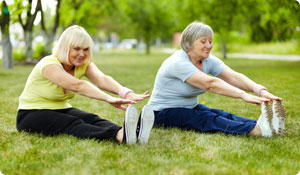
After months of pounding the indoor pavement, it feels great to take it outside. Exercising day in and day out on the same, old treadmill (or bike or elliptical) with the same, old view can get, well, old. Step outside and you'll get more than a dose of fresh air.
A recent study of older adults found those who exercised outdoors worked out longer and more often than those who worked out indoors—accumulating about 30 minutes more each week. And other studies have found people simply enjoyed the activity more outdoors and experienced less stress and fatigue afterwards.
Whether you walk, run, hike, or bike, you'll benefit from exercising outside. Regardless of the activity, you'll need a few essentials: water, sunscreen and the right clothing (reflective for nighttime wear). But here is sports-specific advice on footwear, clothes and equipment for your favorite get-fit activity.
Walking
You'll need a pair of walking shoes with a flexible sole, support for your arches and cushioning for your heels. Shop for walking shoes at the end of the day when your feet are at their largest. Never buy shoes that are slightly tight thinking they'll stretch—they should be comfortable from the first wear. The shoe should be wide enough to give your toes wiggle room. Wear loose-fitting, comfortable clothing and layer in cooler weather. Clothes should be light-colored and reflective for better visibility at dawn, dusk or in the evening. If you perspire a lot, fabrics with moisture-wicking properties can be a great investment.
A watch, or stopwatch, and a pedometer are fun—and motivating to use—since they help gauge activity levels. If you have a smart phone, check out the apps designed to turn walking and running into games that many say add a fun, new element to a walk (or jog) in the park.
Running
If you are flat-footed (overpronated), buying a "motion-control" shoe with arch support is the traditional advice. Alternately, if your feet are high-arched (underpronated), then a shoe with extra cushioning and neutral support is recommended.
However, some studies suggest these accommodations may not be the best way to enhance performance and prevent injury. Instead, go for comfort and proper fit. A sports medicine practitioner, or knowledgeable staffer at a running retail store should be able to guide you in selecting the right shoe for your style of running.
Always dress for the weather to stay comfortable on cooler days, add 15 to 20 degrees to the current temp and dress accordingly. Again, clothing made from the latest fabrics that wick the sweat away from your skin will keep you drier and reduce chafing.
Like walking, you don't need much gear. A running watch can help you track your time and your heart rate. Also good: a running belt to stash money, keys, and ID. And don't leave home without your water! You can buy hydration belts to help you stay hands-free during your run.
Biking
Your bike will be determined by the type of riding you plan to do: Mountain bikes are best for off-road trails, racing bikes for an on-road event, or a "hybrid" bike that is suited for various terrains. Most specialty bike shops can you find the right wheels.
To ensure the proper fit, you should be able to stand over the top bar of the bike with sufficient clearance in case of a sudden stop. The American College of Sports Medicine recommends you straddle the bike with both feet flat on the ground and lift the bike until it contacts your crotch. The tires should be two inches off the ground. You should also be a comfortable distance from the handlebars when seated—not hunched over—and elbows slightly bent (not locked in a straight or bent at 90 degrees).
You'll also need a helmet that fits snugly and sits level on your head. Other essentials: air pump, and a water bottle. Be sure your bike has front and rear lights if you plan to ride at night.
For short rides, regular sneakers and exercise clothing are fine. For longer rides, invest in padded shorts (they help preserve your bum), bike shoes that clip onto the pedals, and bike gloves to help you grip the handlebars when hands are sweaty.
Hiking
If you're new to hiking, a pair of comfortable walking shoes is fine for short hikes on flat terrain. Once you become more committed to the activity, you'll need to invest in a pair of hiking shoes or boots. What to look for: a waterproof boot with a sturdy sole, and padding to protect the sides of the feet. Try them on with the socks you plan to wear with them. (Note: Socks that wick sweat and moisture from the feet are best.) Be sure the boots fit securely so the feet don't slide forward when walking.
Avoid wearing shorts—even on balmy days. Long, lightweight pants are a better option to protect your skin from trail overgrowth, poison ivy and insects like ticks. Carry water and snacks, a small first aid kit, insect repellant and your ID in a daypack worn around your waist or on your back.
Ben Greenfield, MA, reviewed this article.
Sources:
The New York Times. Gretchen Reynolds. "The Benefits of Exercising Outdoors." Web. 21 February 2013. http://well.blogs.nytimes.com/2013/02/21/the-benefits-of-exercising-outdoors/
Consumer Reports. "Get Outdoors and Stay Healthy With the Whole Family." Web. June 2012.http://www.consumerreports.org/cro/2012/06/get-outdoors-and-stay-healthy-with-the-whole-family/index.htm
American College of Sports Medicine. ACSM Fit Society Page. Web. Summer 2012.http://www.acsm.org/docs/fit-society-page/acsmfsp-summer-2012.pdf
"Selecting and effectively using a walking program" Web. 2011.http://www.acsm.org/docs/brochures/selecting-and-effectively-using-a-walking-program.pdf





